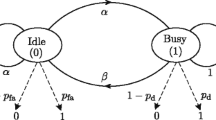Abstract
Various channel status prediction algorithms in cognitive radio networks have been proposed to predict channel availability. However, the existing algorithms predict imperfectly and may cause interference to incumbent users, especially when the prediction output is immediately used to access the channels as it is in spectrum mobility. In this paper, we analyze the prediction errors of the conventional channel status prediction algorithm and propose a novel low-interference channel status prediction algorithm (LICSPA) that suppresses the interference caused by prediction errors. Simulation results show that the proposed LICSPA can effectively decrease interference while keeping the prediction accuracy high.




Similar content being viewed by others
References
Kim, C.-J., Kim, S.-W., Kim, J., & Pyo, C. (2010). Dynamic spectrum access/cognitive radio activities in Korea. In Proceedings of IEEE Symposium on new frontiers in dynamic spectrum (pp. 1–5).
Akyildiz, I. F., Lee, W.-Y., Vuran, M. C., & Mohanty, S. (2008). A survey on spectrum management in cognitive radio networks. IEEE Communications Magazine, 46(4), 40–48.
Kim, H., & Shin, K. (2008). Efficient discovery of spectrum opportunities with MAC-layer sensing in cognitive radio networks. IEEE Transactions on Mobile Computing, 7(5), 533–545.
Yang, L., Cao, L., & Zheng, H. (2008). Proactive channel access in dynamic spectrum networks. Physical Communication (Elsevier), 1, 103–111.
Christian, I., Moh, S., Chung, I., & Lee, J. (2012). Spectrum mobility in cognitive radio networks. IEEE Communications Magazine, 50(6), 114–121.
Yarkan, S., & Arslan, H. (2007). Binary time series approach to spectrum prediction for cognitive radio. In Proceedings of vehicular technology conference (VTC Fall 2007) (pp. 1563–1567).
He, A., Bae, K.-K., Newman, T. R., Gaeddert, J., Kim, K.-W., Menon, R., et al. (2010). A survey of artificial intelligence for cognitive radios. IEEE Transactions on Vehicular Technology, 59(4), 1578–1592.
Clancy, T. C., & Walker, B. D. (2006). Predictive dynamic spectrum access. In Proceedings of SDR forum technical conference (SDR 2006) (pp. 1–5).
Akbar, I. A., & Tranter, W. H. (2007). Dynamic spectrum allocation in cognitive radio using hidden markov models: Poisson distributed case. In Proceedings of IEEE SoutheastCon 2007 (pp. 196–201).
Park, C.-H., Kim, S.-W., Lim, S.-M., & Song, M.-S. (2007). HMM based channel status predictor for cognitive radio. In Proceedings of Asia-Pacific microwave conference (APMC 2007) (pp. 1–4).
Ma, R., Hsu, Y., & Feng, K. (2009). A POMDP-based spectrum handoff protocol for partially observable cognitive radio networks. In Proceedings of IEEE wireless communications and networks conference (WCNC 2009) (pp. 1–6).
Tumuluru, V. K., Wang, P., & Niyato, D. A neural network based spectrum prediction scheme for cognitive radio. In Proceedings of IEEE international conference on communications (ICC 2010) (pp. 1–5).
Tumuluru, V. K., Wang, P., & Niyato, D. (2012). Channel status prediction for cognitive radio networks. Wireless Communications and Mobile Computing, 12(10), 862–874.
Ahmadi, H., Chew, Y. H., Tang, P. K., & Nijsure, Y. A. (2011). Predictive opportunistic spectrum access using learning based hidden markov models. In Proceedings of IEEE 22nd international symposium on personal indoor and mobile radio communications (PIMRC 2011) (pp. 401–405).
Acknowledgments
The authors wish to thank the editor and anonymous referees for their helpful comments to improve the quality of this paper. This research was supported in part by Basic Science Research Program through the National Research Foundation of Korea (NRF) funded by the Ministry of Education (NRF-2013R1A1A2011744). Correspondence should be addressed to Dr. Sangman Moh (smmoh@chosun.ac.kr).
Author information
Authors and Affiliations
Corresponding author
Rights and permissions
About this article
Cite this article
Christian, I., Moh, S. A Low-Interference Channel Status Prediction Algorithm for Instantaneous Spectrum Access in Cognitive Radio Networks. Wireless Pers Commun 85, 2599–2610 (2015). https://doi.org/10.1007/s11277-015-2922-0
Published:
Issue Date:
DOI: https://doi.org/10.1007/s11277-015-2922-0




